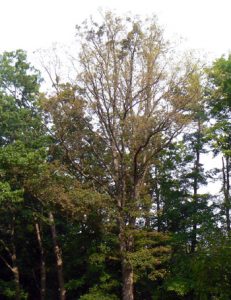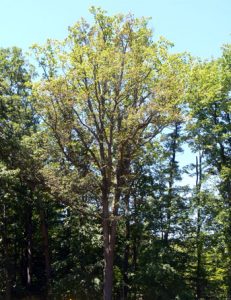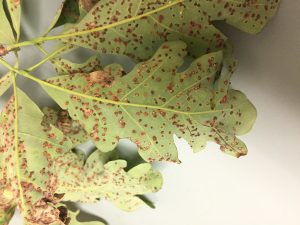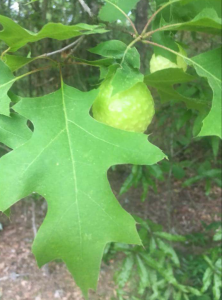Category Archives: Pests
From the Henrico Extension MG Help Desk: Jumping Oak Gall
QUESTION:
My Oak tree has a lot of brown leaves on it. Can you help me determine what is wrong?
DIAGNOSIS / RECOMMENDATION:
What you see in the picture at the bottom are damaged leaves from a non-sting wasp. We commonly see the effects of Jumping Oak Galls this time of year. The amount of leaves impacted on each tree can vary.
We do not have any insecticide treatment options, but the galls have little impact on the tree health. As seen in these photos, the tree suffered almost complete defoliation from infestation, but on the right we see the same tree just a week later full of new leaves. Your tree should be able to care for its own health given time.
To relieve pressure for future years, you can remove all fallen leaves by bagging them and removing them from your property. This will keep some larva from maturing and affecting the tree in future seasons. Also, if drought occurs later in the season water the tree to help relieve stress that may be impacting the tree health.
Photos 1 & 2: Left, A white oak that was nearly defoliated as a result of a severe infestation of jumping oak gall; Right, This is the same tree a week or so later showing new leaves growing. Photo credits: Dave Filipiak
ADDITIONAL INFORMATION:
The brown spots that you see on the leaves are a form of a blister from the tiny seed-like galls located on the underside of the leaves. Each gall serves as an incubator for a single non-sting wasp.
The name Jumping Oak Gall comes from when the larva hits the ground. After the larva hit the ground, you can see them jumping about an inch off of the ground, trying to position themselves on the soil surface to survive the winter.
RESOURCE LINKS:
- http://msue.anr.msu.edu/news/jumping_oak_gall_causing_damage_to_white_oak
- https://www.uaex.edu/media-resources/news/june2017/06-20-2017-Ark-jumping-oak-gall.aspx
All resource links accessed May 31, 2018
PHOTO CREDITS:
Photos 1 & 2: Michigan State University Diagnostic Services, used with permission
Photo 3: Alice Cox, 2018 Henrico County Extension Summer Intern
Do you have a gardening question that the Henrico Master Gardener Volunteers can help you with? The Henrico Extension Master Gardener Horticulture Helpline provides expert advice and guidance on a variety of gardening topics.
The Henrico Master Gardener Horticulture Helpline can be reached at (804) 501-5160, which also serves as the main number for the Extension office. The helpline will be staffed from 12:30 to 4:30 p.m. Mondays and Fridays and from 9 a.m. to noon Tuesdays, Wednesdays and Thursdays through October.
In addition, the public may call from 8 a.m. to 4:30 p.m. weekdays to leave a message. A Master Gardener will respond during the next shift.
For the helpline, a team of volunteer Master Gardeners will have access to a vast library of Extension publications and information on horticulture topics. Henrico’s Master Gardener program provides education and promotes research-based information on horticulture to the gardening public. For more information, go to henrico.us/extension.
Answers provided herein were based on specific situations and growing conditions.These recommendations may or may not be appropriate for all circumstances.For specific recommendations for your particular situation please contact your local Cooperative Extension Office.
From The Henrico Extension MG Help Desk: Oak Galls
QUESTION:
I have an oak tree that has a weird looking fruit on it. Can you help identify it?
DIAGNOSIS / RECOMMENDATION:
Thanks for the pictures. What you see in the picture on the oak tree is a gall caused by a non-sting wasp. It is common among oaks to develop galls at this time of the year. Galls can vary in shape and size.
Galls are usually only cosmetic problems on the oaks. We do not have any treatment options for them. Once you see the gall, the insect is already inside the gall. So if there was a treatment, it wouldn’t get rid of the gall. If you want you can cut out the galls (again, non-stinging wasp, so no concern of getting stung). But I would just leave them. Usually we see galls for a couple of years on a tree, then we won’t see them again for many years, if at all, as part of natures cycles.
ADDITIONAL INFORMATION:
Galls are abnormal growths of plant tissue induced by insects and other organisms. Gall-making parasites release growth-regulating chemicals as they feed, causing adjacent plant tissues to form a gall. The parasite then develops within the relative security of the gall.
RESOURCE LINKS:
All resource links accessed May 8, 2018
PHOTO CREDITS:
Lynn Holterman, used with permission
Do you have a gardening question that the Henrico Master Gardener Volunteers can help you with? The Henrico Extension Master Gardener Horticulture Helpline provides expert advice and guidance on a variety of gardening topics.
The Henrico Master Gardener Horticulture Helpline can be reached at (804) 501-5160, which also serves as the main number for the Extension office. The helpline will be staffed from 12:30 to 4:30 p.m. Mondays and Fridays and from 9 a.m. to noon Tuesdays, Wednesdays and Thursdays through October.
In addition, the public may call from 8 a.m. to 4:30 p.m. weekdays to leave a message. A Master Gardener will respond during the next shift.
For the helpline, a team of volunteer Master Gardeners will have access to a vast library of Extension publications and information on horticulture topics. Henrico’s Master Gardener program provides education and promotes research-based information on horticulture to the gardening public. For more information, go to henrico.us/extension.
Answers provided herein were based on specific situations and growing conditions.These recommendations may or may not be appropriate for all circumstances.For specific recommendations for your particular situation please contact your local Cooperative Extension Office.
National Invasive Species Awareness Week February 26 – March 2, 2018
While the term “invasive plants, pests and diseases” may not be familiar to everyone, the effects of invasive species in Henrico County should be of concern to all of us. Once invasive pests become established, they can grow and spread rapidly, often because they have no natural predators in their new environment. Invasive pests cost landowners, industry and the U.S. government millions of dollars to control, so taking steps to prevent their introduction is the most effective method of reducing both the risk of invasive species infestations and the cost to control and mitigate those infestations.
Henrico residents can help reduce the spread of invasive pests and plants into the county and the Commonwealth by following these simple steps:
1. Learn about invasive species, especially those found in our region. Invasive species such as the Asian longhorned beetle, emerald ash borer, gypsy moth and imported fire ant wreak havoc on the environment and also displace or destroy native plants and insects.
2. Clean hiking boots, waders, boats and trailers, off-road vehicles and other gear to stop invasive species from hitching a ride to a new location. Learn more at PlayCleanGo.org
- Avoid dumping aquariums or live bait into waterways. LearnmoreatHabitattitude.org
- Don’t move firewood – instead, buy it where you’ll burn it, or gather on site when permitted. Gypsy moth egg cases and emerald ash borer larvae can hitch a ride with the firewood and start infestations in new areas. Learn more at DontMoveFirewood.org
- Use forage, hay, mulch and soil that are certified as “weedfree.”
- Consult with your local nursery or master gardener to help you select plants that are not invasive for your landscaping and gardening projects, and remove any known invaders.
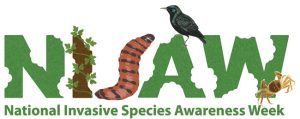 Volunteer to help remove invasive species from public lands and natural areas.
Volunteer to help remove invasive species from public lands and natural areas.

